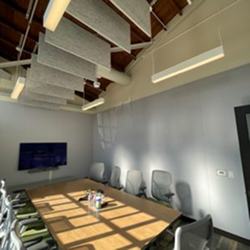
Sound Control Needs for HVAC Noise
HVAC systems are key to climate control in modern buildings. However, they can sometimes produce excessive noise. This can result from poor initial design, changes in the space layout without adjusting the HVAC system, or maintenance issues. Excessive noise can disrupt work environments, interfere with communication, and negatively affect video conferencing in areas such as offices, conference rooms, and meeting spaces.
Common causes of HVAC noise include undersized diffusers, poorly designed ductwork, and malfunctioning mechanical components. When diffusers are too small or improperly sized, they force air through small openings, creating a “whistling” sound. Turbulence in ducts, especially at bends or direction changes, can produce rumbling noises.
Excessive airflow or vibrating ducts may also contribute to unwanted noise. Additionally, worn bearings, loose covers, or other mechanical issues can cause vibrations that amplify the noise.
ASHRAE (The American Society of Heating, Refrigeration and Air-conditioning Engineers) has established noise criteria (NC levels) to guide HVAC system design based on the space being conditioned. Solutions to reduce HVAC noise include adjusting or resizing diffusers, installing turning vanes in ducts, and adding sound-damping materials. Mechanical issues can be resolved by replacing worn parts and adding soundproofing to equipment. This improves both noise levels and HVAC efficiency.

How We Help with HVAC Noise Reduction
Executing HVAC noise reduction requires a comprehensive approach that begins with diagnosing the noise source. Sound Management Group’s experience in the field allows us to pinpoint issues ranging from faulty diffusers to vibrating ducts.
Adjusting or replacing diffusers reduces air velocity and eliminates the "whistle." We also address duct resonation with turning vanes and dampening materials. For mechanical noise, we use vibration mounts, enclosures, and dampening liners.
Beyond direct adjustments to HVAC systems, we also focus on isolating noise from traveling into other spaces. Sound traps, duct liners, and sound masking can help make sure that noise generated by HVAC systems does not interfere with adjacent rooms or open areas.
We also offer custom acoustical treatments to meet the specific needs of your space. With our wide range of solutions, we help create quieter, more productive environments for your business.
Gallery +












